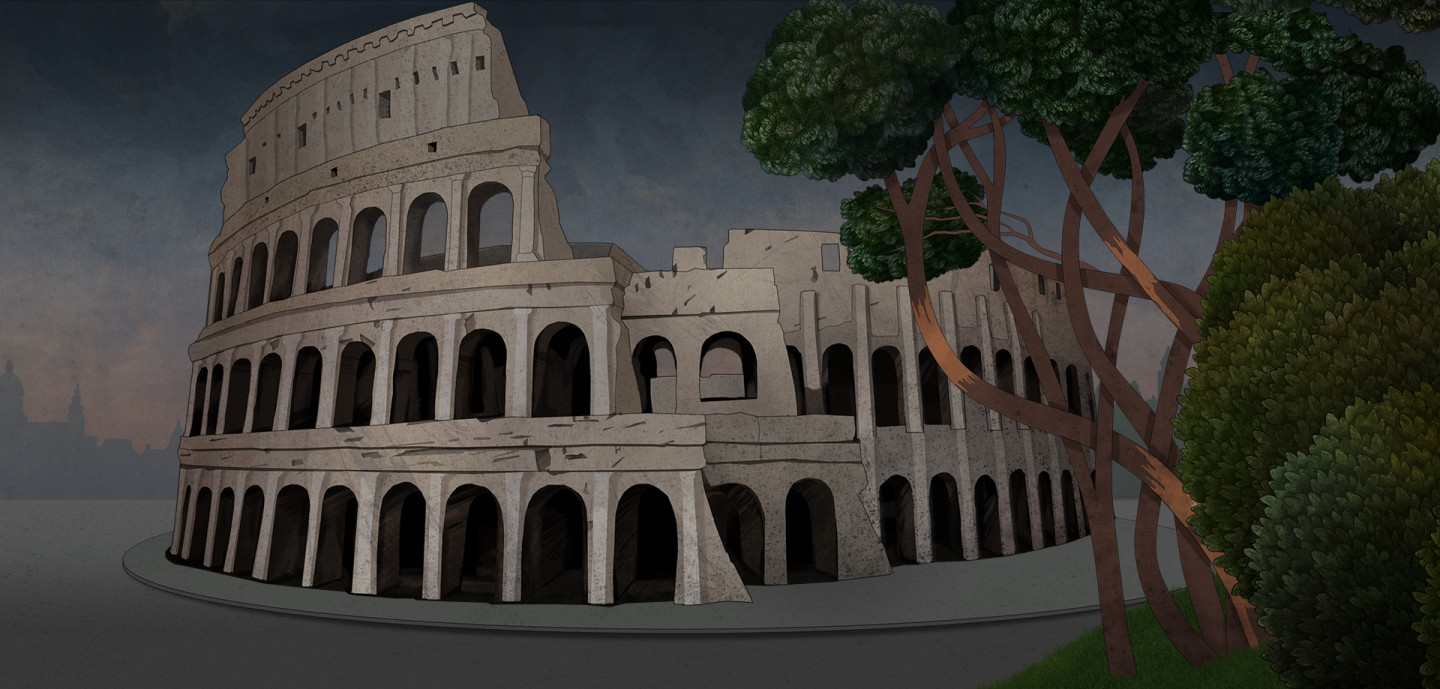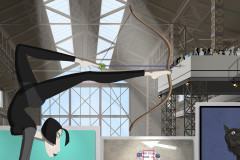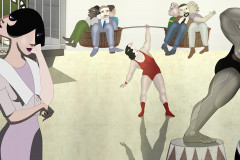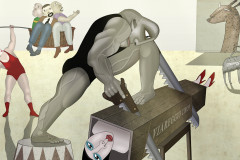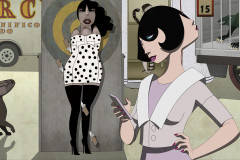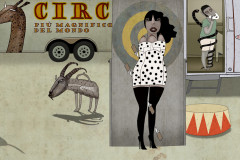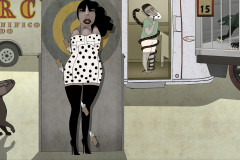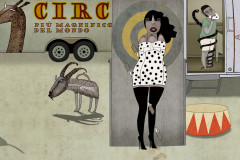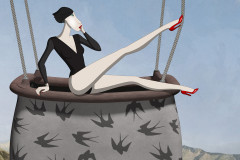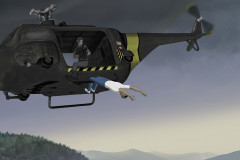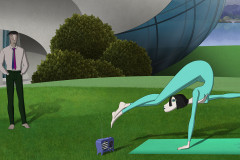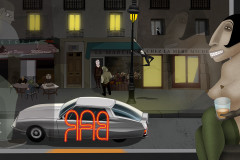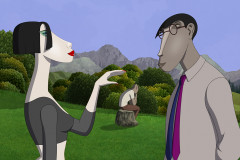A „cirkusz” szót már az ókori Rómában is használták a látványos tömegszórakoztatás megnevezésére. Ma is ismert Juvenalis, a Kr. u. 1. századi szatíraköltő frappáns mondása: „Panem et circenses!” (Kenyeret és cirkuszt!). Ez a velős kijelentés arra utalt, hogy a császárkori Rómában a széles néptömegek elvesztették a politikai súlyukat, és csak két dolog érdekelte őket: a létfenntartás és a szórakozás. De becsapós, hogy ugyanazt a szót használjuk az ókori cirkuszi játékokra és a mai cirkuszművészetre. A Colosseumba betömörült emberek ugyanis nem műlovarnőket és zenebohócokat néztek nagy gyönyörűséggel. Hanem mit is?
A görög „kírkosz” vagy latin „circus” szó eredetileg kört jelent. (Innen jön pl. a „cirkál” vagy a „cirkó” szavunk is.) De már az ókori Görögországban és Rómában ezzel a névvel kezdték illetni a kör vagy ellipszis alakú színpadokat, arénákat. Az ott zajló látványosságok azonban durvábbak és gyakran véresebbek voltak, mint a mai cirkusz: kocsiversenyek, állatviadalok, gladiátorharc volt műsoron. A nemegyszer életre-halálra menő küzdelem nagy élvezetet jelentett a nem túl kifinomult közönségnek. A küzdők számára viszont büntetés vagy rabszolgaként rájuk mért sors volt, hogy részt kellett venniük a cirkuszi játékokon.
Tehát sok hasonlóság nincs a mai és az ókori cirkusz között, csak a kör alakú színpad – és persze a közönség heves érdeklődése. A mai formájában ismert cirkusz 250 évvel ezelőtt jött létre. 1769-ben a lovasiskolát működtető Philipp Astley Londonban állandó előadóhelyhez jutott, és a lovasszámokat artistákkal és bohóccal egészítette ki. Astley szeme előtt olyan színházi műfaj lebegett, ami mindenki számára érthető. Lóháton előadott némajátékokkal elevenített meg közismert vagy aktuális történeteket, pl. a Bastille ostromát. Bár Astley élete végéig küzdött a cirkusz elnevezés ellen, őt tartjuk a modern cirkusz megalapítójának.
A cirkusz színpada, a manézs, ma is kör alakú, mégpedig általában 13 méter átmérőjű. De miért pont annyi? Ez a kérdés is a 18. századi Londonba visz vissza. A cirkuszi előadások gerincét akkoriban a lovasszámok adták. Például a műlovaglás, artistamutatványok lóháton vagy egy különleges színházi forma, a lovas pantomim. Már Astley kikísérletezte, hogy egy 13 méter átmérőjű kör már elég nagy ahhoz, hogy úgy lehessen körbefuttatni vezetőszáron a lovat, hogy az alig dől be a kanyarban. A körpályán való egyenletes mozgás segíti a lóháton ügyeskedő artistákat, hiszen rábízhatják magukat a centrifugális erőre; a ló háta pedig többé-kevésbé vízszintes marad. És bár ma már egyre kevesebb lovas szám bukkan fel a cirkuszok műsorában, a manézs standard mérete máig megmaradt.
From Bloodsport to Big Top: The Origins of the Circus
The word circus was already in use in ancient Rome to describe grand public spectacles. The Roman satirist Juvenal famously wrote in the 1st century AD: “Panem et circenses!” (“Bread and circuses!”). This sharp phrase pointed to the reality of imperial Rome, where the masses had lost their political power and were interested only in survival and entertainment. But it’s misleading to assume that ancient and modern circus have much in common beyond the name. After all, the crowds packed into the Colosseum weren’t there to enjoy trick riders or musical clowns. So what were they watching?
The Greek word kirkos and the Latin circus both originally meant “circle.” (This root also appears in Hungarian words like cirkál and cirkó.) In ancient Greece and Rome, the term came to refer to the circular or oval arenas where large-scale spectacles took place. But the performances were far more brutal than what we associate with the modern circus: chariot races, wild animal fights, and gladiator duels were the main attractions. These often-deadly events thrilled a not-so-refined audience, while the performers—many of them enslaved or condemned—had little choice but to participate.
So in truth, there’s not much resemblance between the ancient and modern circus, apart from the circular stage—and the audience’s passionate attention. The modern circus as we know it began just 250 years ago. In 1769, equestrian instructor Philipp Astley secured a permanent venue in London, where he combined horse-riding shows with acrobats and clowns. Astley envisioned a theatrical form that would be accessible to all. On horseback, his performers acted out silent dramas based on well-known or current events—such as the storming of the Bastille. Though Astley resisted the term circus throughout his life, he is widely recognized as the founder of the modern circus.
The circus ring, or manège, is still circular today—typically 13 meters in diameter. But why that exact size? Once again, we return to 18th-century London. At that time, equestrian acts were the backbone of circus performances—trick riding, acrobatics on horseback, and a special form of theater called equestrian pantomime. Astley discovered that a 13-meter diameter was just large enough to allow a horse on a lead to canter in a steady circle without leaning too sharply into the curve. This even, centrifugal motion provided a stable surface for performers, whose balance and tricks relied on a relatively flat horse back.
Though horse acts are now rare in the circus, the standard size of the ring remains—a lasting trace of the circus’s equestrian origins.






